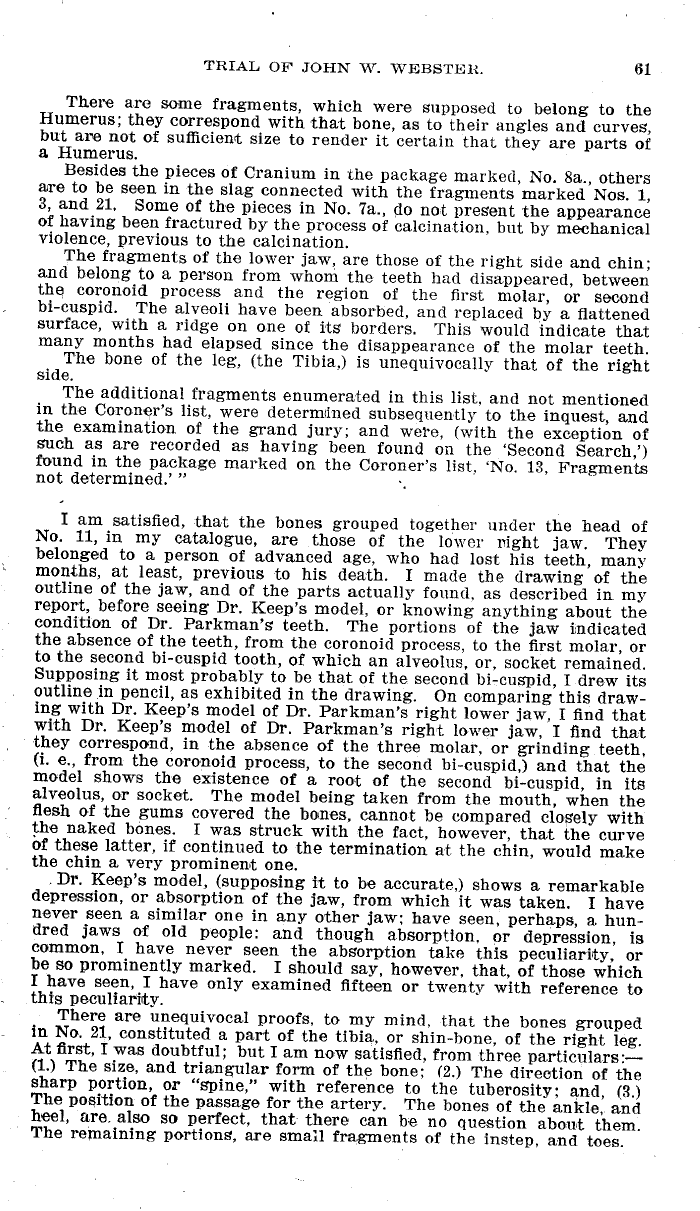|
TRIAL OF JOHN W. WEBSTER. 61
There are some fragments which were supposed to belong to the
Humerus; they correspond with that bone, as to their angles and curves,
but are not of sufficient size to render it certain that they are parts of
a Humerus.
Besides the pieces of Cranium in the package marked, No. 8a., others
are to be seen in the slag connected with the fragments marked Nos. 1,
3, and 21. Some of the pieces in No. 7a., do not present the appearance
of having been fractured by the process of calcination, but by mechanical
violence, previous to the calcination.
The fragments of the lower jaw, are those of the right side and chin;
and belong to a person from whom the teeth had disappeared, between
the coronoid process and the region of the first molar, or second
bi-cuspid. The alveoli have been absorbed, and replaced by a flattened
surface, with a ridge on one of its borders. This would indicate that
many months had elapsed since the disappearance of the molar teeth.
The bone of the leg, (the Tibia,) is unequivocally that of the right
side.
The additional fragments enumerated in this list, and not mentioned
in the Coroner's list, were determiined subsequently to the inquest, and
the examination of the grand jury; and were, (with the exception of
such as are recorded as having been found on the `Second Search,')
found in the package marked on the Coroner's list, `No. 13, Fragments
not determined."'
I am satisfied, that the bones grouped together under the head of
No. 11, in my catalogue, are those of the lower right jaw. They
belonged to a person of advanced age, who had lost his teeth, many
months, at least, previous to his death. I made the drawing of the
outline of the jaw, and of the parts actually found, as described in my
report, before seeing Dr. Keep's model, or knowing anything about the
condition of Dr. Parkman's teeth. The portions of the jaw indicated
the absence of the teeth from the coronoid process, to the first molar, or
to the second bi-cuspid tooth, of which an alveolus, or, socket remained.
Supposing it most probably to be that of the second bi-cuspid, I drew its
outline in pencil, as exhibited in the drawing. On comparing this draw-
ing with Dr. Keep's model of Dr. Parkman's right lower jaw, I find that
with Dr. Keep's model of Dr. Parkman's right lower jaw, I find that
they correspond, in the absence of the three molar, or grinding teeth,
(i. e., from the coronoid process, to the second bi-cuspid,) and that the
model shows the existence of a root of the second bi-cuspid, in its
alveolus or socket. The model being taken from the mouth, when the
flesh of the gums covered the bones, cannot be compared closely with
the naked bones. I was struck with the fact, however, that the curve
of these latter, if continued to the termination at the chin, would make
the chin a very prominent one.
Dr. Keep's model, (supposing it to be accurate,) shows a remarkable
depression, or absorption of the jaw, from which it was taken. I have
never seen a similar one in any other jaw; have seen, perhaps, a hun-
dred jaws of old people: and though absorption, or depression, is
common, I have never seen the absorption take this peculiarity, or
be so prominently marked. I should say, however, that, of those which
I have seen, I have only examined fifteen or twenty with reference to
this peculiarity.
There are unequivocal proofs, to my mind, that the bones grouped
in No. 21, constituted a part of the tibia or shin-bone, of the right leg.
At first, I was doubtful; but I am now satisfied, from three particulars:
(1.) The size, and triangular form of the bone; (2.) The direction of the
sharp portion or "spine," with reference to the tuberosity; and, (3.)
The position of the passage for the artery. The bones of the ankle, and
heel, are, also so perfect, that there can be no question about them.
The remaining portions, are small fragments of the instep, and toes.
|

